Content
- 1 Beautiful roses of the Topalovich brothers
- 2 Beautiful roses by David Austin
- 3 Origin, history of the appearance of the royal flower
- 4 Varieties and varieties of roses

What varieties of roses grow on your site? Which ones would you like to try to grow? The variety of roses existing today is so huge that even with a strong desire, life will not be enough to experiment with all known varieties. Therefore, flower growers so carefully choose the types of roses and individual varieties worthy of taking a place among other plants in the flower garden.
Types and varieties of roses ideal for the Russian climate
But the complexity of the choice lies not only in the fact that the eyes run up from the presented assortment - not every variety of roses can be grown due to the peculiarities of the local climate. Nevertheless, in most of the territory of Russia, the summer is very short, and the winter is frosty, which is why the delicate roses do not gain color or even freeze out. Let's look at varieties that have long been successfully grown in domestic gardens.
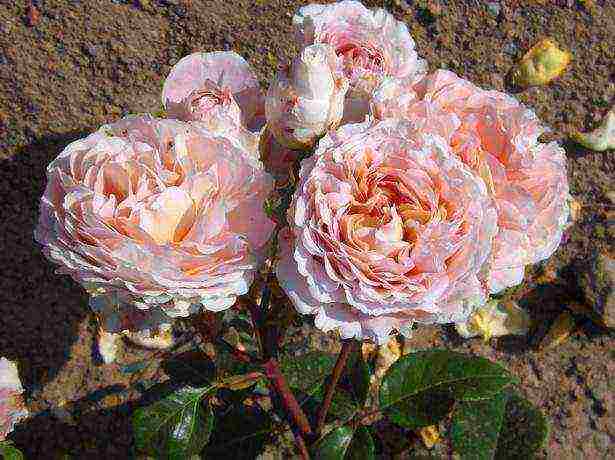
For open ground, choose those varieties that are least susceptible to damage in winter.
As good as the Dutch roses, presented in every flower shop in the form of luxurious bouquets and elegant single flowers, are very difficult to grow them in our climate. Their delicate root system is not able to withstand severe frosts, and in general Dutch roses are very capricious - at best, you can achieve success by growing these roses in a greenhouse or at home in pots, surrounding the flowers with maximum attention and care.
Video about varieties of roses
For open ground, choose those varieties that are least susceptible to damage in winter. For example, park roses and rose hips (wild rose) are considered the most resistant to frost. The best frost-resistant varieties include such a variety as the Cordes roses.
Winter hardy roses native to snowy Canada
Not only our country is famous for long snowy winters and strong frosts - Canada is located in similar latitudes, and local gardeners have the same problems with growing roses. But it was Canadian breeders who came to grips with breeding winter-hardy roses, starting their work at the end of the 19th century. Since then, Canadian scientists have achieved excellent results, and Canadian roses have become famous all over the world for their unique qualities. These flowers are able to withstand frosts down to -40 degrees, are not afraid of diseases and even in adverse conditions grow abundantly and continuously.
Officially, only the Explorer and Parkland groups belong to Canadian roses, however, flower shops often sell American-bred varieties and old frost-resistant wrinkled roses in the guise of Canadian roses. The winter hardiness of the Explorer and Parkland varieties is different - some roses are well able to withstand our winters, while others freeze to the level of snow, but then recover and bloom well in summer. Even with the complete freezing of the aerial part, Canadian roses grow again from the buds on the roots.
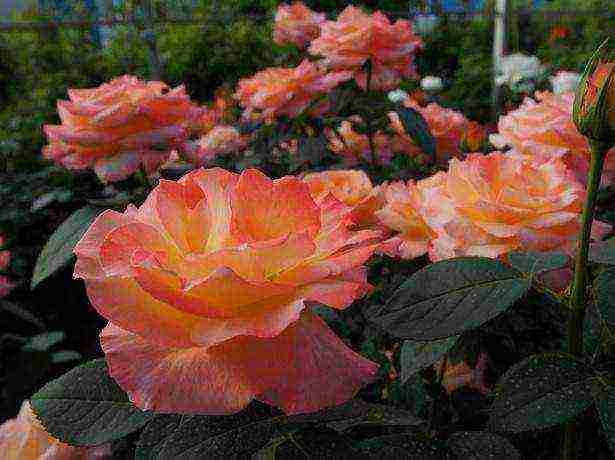
Even with the complete freezing of the aerial part, Canadian roses grow again from the buds on the roots.
The best winter-hardy varieties of the Explorer series: John Cabot, Alexander MacKenzie, Lambert Closse, Marie-Victorin, Louis Jolliet, Quadra. In a series of "Canadians" Parkland, the following varieties are distinguished by special winter hardiness: Winnipeg Parks, Hope for Humanity, Cuthbert Grant, Morden Ruby.
Beautiful and unpretentious "coastal flower" - Rugosa rose
What florist does not dream of roses that are ideal in every respect - beautiful, blooming all season, with a pleasant aroma, that do not need shelter for the winter and special care, that can grow well in partial shade, on salty soil and even on sand? There is such a rose, it came to us from the Far East, where it has earned the poetic name "coastal flower" due to the fact that it is often found on the coast. In Russia, it is better known as wrinkled rose or rugosa.
Wrinkled rose bushes are ideal for creating a flowering hedge - the plant forms dense thickets in the shortest possible time due to root suckers, while the bushes are abundantly dotted with sharp thorns. The first wave of flowers appears earlier than other varieties of roses, and throughout the summer, new flowers continue to form, and by the fall, beautiful fruits of bright orange color ripen. Not surprisingly, the wrinkled rose is considered one of the best varieties to grow in our climate.

Wrinkled rose bushes are ideal for creating a flowering hedge
Recommended varieties of Rugosa rose:
- Grootendorst series (pale pink flowers Pink, pure white White and dark crimson Supreme);
- Frau Dagmar Harlopp - blooms on salmon pink flowers on any soil, surprisingly unpretentious;
- Rugosa Alba is a popular variety with purple-red, non-double flowers;
- Sarah Van Fleet with very fragrant pale pink double flowers;
- Roseraie de I’Hay with wine-red double flowers is very hardy and unpretentious;
- The Queen of the North is the hardiest red-flowered variety suitable for fairly cold regions.
Other varieties of roses adapted for Russian winters 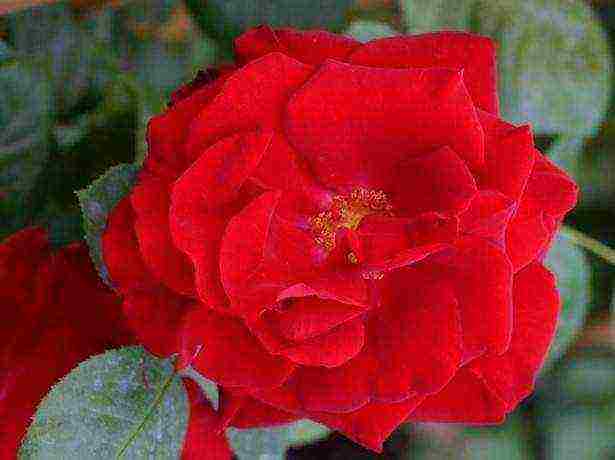
Rose Santana
Among the most popular winter-hardy varieties in our country, a special place is occupied by climbing rose santanabelonging to the Climber group. Of the red roses, velvety bright red Santana is considered one of the most beautiful. Large semi-double flowers with slightly wavy petals abundantly cover vigorous dense bushes throughout the summer season until the first frost. The height of the bush can reach two and a half meters, and in some cases grows up to four meters. You can grow the Santana rose as a shrub or as a climbing plant. The variety is quite resistant to common diseases and is not afraid of rain.
Another notable variety from the climbing group is New dawn... These roses are planted in groups or singles in a flower garden, and are also used for vertical gardening. On the bushes of the New Dawn variety, charming pale pink double roses with a diameter of up to seven centimeters are formed. The flowers are collected in inflorescences and exude a wonderful apple aroma. Flowering lasts from mid-June to mid-October. One of the best autumn varieties of roses, even in severe winter frosts, its apical shoots only slightly freeze.
The unpretentious frost-resistant variety of hybrid tea rose is highly valued throughout Europe. Madame Meilland (Meiland), which has different names in different countries: Fredsrosen, Gloria Dei, Mme Antoine Meilland, Peace, Beke, Gioia. Roses look very elegant at any stage of flowering - from elegant creamy buds to lush blossoming flowers with a pink border, exuding a pleasant fragrance. The aroma of roses and the color of the flowers largely depend on the place of cultivation.
Video about varieties and selection of roses
From the group of grandiflora roses, it is worth noting the variety Quin elizabeth with cupped large double flowers of traditional pale pink color. Flowers, reaching a diameter of twelve centimeters, are located on the bushes singly or in the form of inflorescences. Flowering lasts from June to October with short breaks. In addition to its high winter hardiness, the variety is resistant to fungal diseases.
Novice growers can start growing roses by growing popular floribunda varieties.Abundantly blooming floribunda roses are less whimsical than hybrid tea, they are more resistant to frost and fungal diseases, they are ideal for a small area. Common varieties: Masquerade (dark red, yellow, pink flower color), Amber Queen (amber color), Allgold (golden yellow variety, very easy to grow), Chanelle (reliable variety with peach-colored roses), City of London (bright pink), Korresia (with very fragrant golden flowers that are not afraid of rain), Parfait (creamy pink roses for universal use).
Rate the article:
(0 votes, average: 0 out of 5)
Any festive event is rarely complete without flowers. They are used to decorate premises, decorate streets and courtyards. Of course, the first place among the wide range of cut crops is the rose. Many women love these flowers for their indescribable beauty, aroma, variety of shapes and colors. What are the most beautiful among them? Rose varieties that can be attributed to this category are not only sold in flower shops, but also grown by experienced summer residents.
It is very difficult to choose the most beautiful among the wide range of popular roses. The experience of many gardeners and florists, as well as summer residents, will help you decide on which types of beautiful roses you should focus your attention.
Among the many varieties, there are those that are classified by many summer residents, flower growers and amateurs in the category of whimsical crops. These include:
- Rose de Resht. This is the so-called Portland variety, the characteristic feature of which is a persistent, heady aroma, which is emitted by large flowers of an unusual shape. Some gardeners and lovers position Rose de Resht as exotic roses for this very reason. The first mentions of these flowers were recorded in the 17th century in Iran. (Resht is the name of one of the Iranian cities). Experts note that it was from this corner of the planet that Rose de Resht came to Europe. A feature of the culture is the continuity of flowering. In place of the cut flower, a new one immediately appears. Thus, it belongs to the beautiful varieties of roses that bloom all summer.
- Golden Showers. Very beautiful roses, despite the promising name, which gives the characteristic of the shape of the bush (thin stems hanging above the soil surface), the flowers bloom only once a year and the flowering period lasts no more than 7 days. The petals seem to be covered with a velvet blanket, and the plant itself is gaining strength. At the end of flowering, the stems do not fade, continuing to grow until frost. During this period, you can form a bush.
- Vendela. A finicky variety of roses. It is susceptible to fungal infections. The Vendela rose seedling must be very well protected against harmful microorganisms. This plant requires careful care and special attention from the grower. It is necessary to especially monitor the balance of moisture, since transfusion can provoke the development of fungal diseases. Therefore, many summer residents spend a lot of time growing these flowers at home. But the result is worth it.
- Eiffel Tower. This variety of beautiful roses also requires a lot of attention, because of this, novice growers spend a lot of time. It is recommended to grow them under cover when temperatures fluctuate rapidly. According to reviews, Eiffel Tower is very beautiful, has a heady aroma, which is emitted by flowers of a delicate crystal-pink hue.
- Bleu Magenta. Very rare but beautiful roses (see photo). This forces many growers to take up the cultivation of Bleu Magenta. The flowers have a deep purple-purple hue. The plant belongs to undersized, reaches about half a meter in height. On the dense clusters of one bush, you can count up to 25 flowers. The flowering period lasts about a month. The leaves are very small with a glossy, shiny surface. Shoots have almost no thorns.The plant is very demanding of itself.
Beautiful roses of the Topalovich brothers
In all corners of the world, with great diligence, many growers are engaged in the cultivation of scrub roses. The word "shrub" in translation from English means "bush". Therefore, it is not difficult to guess what it is about. Shrub roses are very popular as they are grown commercially. But in many summer cottages, you can see shrub roses that adorn flower beds and florists.
In Serbia, there is a very popular and one of the best nurseries in Europe, which grows beautiful varieties of roses (see photo), and it is named after the Topalovic brothers. Its history begins in 1931. Despite many difficulties, it has preserved its primitiveness, which is now combined with innovative approaches to breeding beautiful species of roses. As a result of their activities, many exotic varieties have been bred. The nursery "Brothers Topalovich" for the entire period of its breeding activity has received many awards and recognition in many countries of the world.
A distinctive feature of the nursery roses is the combination of the classic waviness of double petals with large flowers, the diameter of which is not less than 10 cm. They are also characterized by bright colors of buds, strong stems, splendor of bush forms.
Many experts note good resistance to cold weather and absolute immunity to some pests (aphids, locusts).
What is the most beautiful variety of roses? The most popular are:
Despite the many advantages, these roses require careful, painstaking and attentive care.
Beautiful roses by David Austin
The famous breeder from England David Austin experimented for many years to create the unusual beauty of roses. In his numerous studies, he used several types of plants (bourbon, floribunda, tea and some varieties of French roses). In his deepest dreams, the goal was to combine modern colors and continuous flowering without losing the classic beauty inherent in roses. And this dream became a reality, which made it possible to position its varieties in a separate group - Austin roses (Ostinki). The colors are dominated by shades of peach, red, apricot, yellow.
The Ostins have very beautiful, compact, powerful bushes, on which abundantly flowering large-flowered inflorescences are located. The diameter of each bud reaches about 13 cm. The petals are terry and do not fade in the sun, delighting people for a long time with their indescribable beauty.
The most beautiful varieties of roses (see photo), bred by David Austin, bloom in waves, but the break between these periods is small (about 14 days). The height of each bush reaches a meter in height. This makes them very attractive.
Beautiful varieties of roses (photo with names):
Austin's most fragrant roses:
The most beautiful varieties of roses with abundant flowering:
The most beautiful roses (photo) with two-tone, saturated shades:
There are also varieties of beautiful roses that can form flowers on the same shoots for up to 3 years:
Flower lovers (and we are among them) are worried: how are our roses in the country? This year's winter is classically abnormal. In many regions there was no snow for a long time, although there were no severe frosts. Then it got colder. Then snow fell, and more than necessary. Now here is the dancing temperature, streams are flowing. Then frost will hit again and everything will be covered with a layer of ice ... Poor plants!
How they will survive the next bad weather, we will find out in the spring. But so that every winter I study the weather forecast not to clutch at my heart, heed the advice of a specialist.
The well-known rose collector, Muscovite Alexei Stepanov, tested many different roses on his site and compiled a list of the most reliable ones. It included 30 varieties. And they all meet 5 main criteria:
1. Excellent health. This is one of the main qualities, since a sick rose does not just spoil the appearance of the flower garden, it also hibernates badly. Or even dies. After all, the affected leaves fall off ahead of time, and the plant simply does not have time to ripen.
2. Stable wintering. In different areas, in different conditions and with different shelters, they are still able to survive our severe frosts.
3. Abundant and long flowering. There are no such roses in nature to bloom without interruption all summer, but these varieties will inflate as long as possible.
4. Resistance of flowers to bad weather. They are not afraid of rains, moisture and heat - in any case, they retain their decorative effect.
5. Good shoot regrowth. This is important when the aerial part of the plant dies after an unsuccessful wintering. After all, the more new stems grow, the more flowers there will be.
So, roses that won't let you down.
Hybrid tea
Gloria deiMeilland, 1945 This unsurpassed masterpiece is called the number 1 rose in the world. She is really magnificent: her flowers are large, yellow with tints and pink edging of the petals.
The only drawback is that each flower lasts only 3 days.
Ingrid bergmanOlesen, 1984 Gorgeous, dark red, with almost black buds - this is without exaggeration the best red variety for the middle strip. Perfect and inimitable. The bush grows quickly, the flowers last up to 2 weeks and are not at all afraid of rains.
AphroditeTantau, 2006 No wonder this rose was named after the goddess of love and beauty - she is the embodiment of beauty! Her flowers are 10–12 cm in diameter, porcelain-pink in color. They tolerate rain well. The bush is low, up to 80 cm.
Hommage a barbaraDelbard, 1997 Perhaps the best rose in the Delbard collection. Her flowers are delightful burgundy with black bloom and wavy petals. Each shoot blooms 1 bud, but there are always a lot of stems on the bush, the flowers last up to 2 weeks and are not at all afraid of rains.
FloribundaThere are 7 varieties in this group at once. They are delightful. They are resilient. They will decorate any garden!
Sangerhause jumbileumroseKordes, 2003 Its delicate, large (up to 9 cm in diameter) flowers in apricot-pink tones look very impressive against the background of dark green foliage. Branched bush. Not afraid of disease, heat or rain. Blooms all summer and is very abundant.
Leonardo da VinciMielland, 1993 As you know. Leonardo da Vinci was the greatest artist and ingenious inventor. And the rose, named in his honor, as if seeks to justify the high honor shown to her. Her bush is straight and compact. In the first bloom, it is literally strewn with bright pink pom-pom flowers, very close in shape to the old varieties.
The only drawback of this beauty is that she almost does not smell. But it never fails.
Lios-roseKordes, 2002 She is always included in the top ten charts compiled by a survey of rose lovers - in terms of reliability, she is not equal! Cream-white flowers bloom slowly on large clusters and change shape daily.
The disadvantage of a rose is that in the middle lane it wakes up much later than other roses, develops slowly and blooms only at the end of July. Therefore, the second time does not have time to bloom. But in our harsh conditions, this disadvantage turns into a huge plus, because, failing to plant the buds again, the rose has time to prepare for the cold and always winters well.
PastellaTantau, 2004 The bush of this wonderful variety is very beautiful, with bright dark green foliage. Flowers 7–8 cm in diameter, unusual creamy white color with pinkish and green tints. They are collected in multi-member clusters that bloom profusely and continuously. The rose has excellent health and winters well.
Jubile du prince de monacoMielland, 2000 The main advantage of this rose is its "long-lasting" flowers, each of which lasts up to 2 weeks and at the same time constantly changes color: at the time of dissolution, they are white with a red edging, then turn red, and as they fade, they become white-green.
The rose has two drawbacks - it does not smell and in unfavorable years it is affected by black spot. But on the other hand, it feels great in gray latitudes.
Gebruder GrimmKordes, 2007 This rose has been awarded the ADR quality mark, which is awarded to the most decorative and resistant varieties. Her flowers are of a unique yellow-orange-red color.Small, 6–7 cm in diameter, but always collected in large racemes. It always creates a bright accent in the garden, so it is better to plant it separately from other roses, for example, against the background of conifers. Otherwise, she will draw all attention to herself and other varieties next to her will be lost.
PomponellaKordes, 2005 She is short, but blooms very profusely. Her flowers are small, pom-shaped, intense pink, collected in large brushes of 15-30 pieces!
ShrubsThis group also has a fairly extensive selection of stable and unpretentious roses - 7 varieties that will not let you down and will delight you with health and abundant flowering.
WesterlandKordes, 1969 Very spectacular and unusual rose - her bush grows quickly and blooms in two pronounced waves. The flowers are semi-double, copper-orange. And although each of them lasts only 3 days, they take in quantity - there are a lot of buds in the brushes and new ones are constantly replacing the fallen ones. In very harsh winters, it can freeze slightly, but quickly recovers. Possesses the ADR quality mark - for high decorative effect and durability.
AngelaKordes, 1984 The flowers of this wonderful rose are medium-sized, up to 4 cm in diameter, but an incredible amount of them is formed. They are bright pink in color, collected in numerous brushes, which cover the leaves. In catalogs in photographs, she usually does not look very presentable, and flower growers often bypass her with their attention. But those who planted were not disappointed - this is a real queen! Nothing sick and all in bloom. No wonder she was awarded the ADR quality mark.
Bonica 82Mielland, 1985 The ideal rose for beginners! She easily forgives mistakes in pruning and shelter for the winter, and every summer she pleases with abundant flowering. Her flowers are light pink, slightly fading. They are not large, 5–6 cm in diameter, but they open constantly, in any weather, right up to the snow!
The only drawback is that it doesn't smell at all.
Rhapsody in blueFrank R. Cowlishaw, 1999 This is the only blue rose in the top 30. And this is the bluest of all roses! More precisely, it is blue-violet. The flowers are not large, but collected in large brushes. Rain resistant. The bush grows up to 1.5 m and looks very impressive surrounded by dense yellow roses.
Louise Odier (Madame de Stella)Margottin, 1851 Notice the year it was bred - it is over half a century old! This is an old Bourbon variety that will give odds to many modern ones. Very hardy and winter hardy. It can even be left without shelter in the winter. The bush, of course, freezes above the snow level, but quickly recovers. With good cover, the plants are tall and very dense. The flowers of this rose are of an old cupped shape, 5–7 cm in diameter, dark pink in the center and lighter at the edges. And what a smell! Saturated, strong.
By the way, it is from this variety that rose oil is most often made and jam is brewed.
LarissaKordes, 2008 It appeared on the market relatively recently, but has already managed to conquer gardeners with excellent health and abundant flowering. Its flowers are small, 5–6 cm in diameter, pale pink, densely double, old-fashioned, collected in large brushes. This variety will perfectly complement English roses with large flowers.
Guy SavoyDelbard, 2001 The only rose with striped petals to make it to the list of trusted varieties. It is so powerful that in France it is recommended to make hedges from it. In our conditions, it is, of course, a little more modest, but, nevertheless, it grows up to 1.5 m, forming very tough shoots. They cannot be bent down for the winter, so the bush has to be cut to the height of the shelter. The flowers of this rose are weakly double, but large, of a rare pomegranate shade with white strokes. Each brush contains 9–20 buds.
EnglishThis group included 5 varieties that showed themselves at their best in the harsh conditions of Russian reality.
Graham thomasAustin, 1983 This is one of the best varieties of selection by David Austin. Several years ago, he was the last, 14th in a row, to take a place in the World Rose Hall of Fame. It blooms very profusely.His flowers are bright yellow, do not fade and are considered the standard of yellow in roses. In our climate, it will grow very quickly, reaching a height of 2 m.
Crown Princess MargaretaAustin, 1999 An incredible variety - during the flowering season, its shoots are covered with caps of densely double light orange flowers of an old shape with a strong aroma. It can be grown like a climbing rose, with minimal pruning, keeping the shoots from last year. In this case, it will bloom almost along their entire length.
James galwayAustin, 1985 This variety in warm countries forms a powerful bush 2 m high and the same size in circumference. However, in Russia it does not work that way - the shoots are very hard and it is impossible to bend them to the ground, so you have to cut them to the height of the shelter. The flowers of this rose are cold pink, very fragrant, collected in a brush.
Mary roseAustin, 1985 This is one of the first varieties that brought David Austin worldwide fame. The qualities of the variety are outstanding. Tall and strong arched shoots create a beautiful bush shape. They fit easily for wintering. Cold pink flowers with a lilac tint fully convey the charm of real old roses. One of the first to bloom in the garden, and one of the last to finish flowering.
Crocus roseAustin, 2000 The most popular flowering rose in our country. A powerful, spreading bush grows quickly - this variety has never had problems with replacing shoots. Her flowers are white, with an orange center - they look just amazing!
GroundcoverThere is only one variety here - only it has fully shown itself to be reliable and very decorative.
Sunny roseKordes, 2001 This variety fully justifies its name ("sunny" in English means "sunny") - if you want to have a yellow carpet in your garden, then it was created especially for you! Pleases with abundant, almost continuous flowering. In brushes up to 12 large rich yellow, fading to creamy flowers. An adult bush covers an area of about 1 sq. m. It has the ADR quality mark.
ClimbingThere are quite a lot of reliable roses in this group - 6 varieties at once have shown themselves at a height in our difficult climatic conditions.
FlammentanzKordes, 1955 A very spectacular rose with red petals. It blooms once, but so abundantly that it literally overshadows other roses! Her flowers are resistant to rain, open in any weather and stay on the bush for a long time. It grows well on its own roots and perfectly cuttings, therefore it wanders from garden to garden.
Rosarium UetersenKordes, 1977 Growing fast. It blooms profusely all season with bright crimson flowers. It is considered a petite, but in our climate it does not grow to the declared size and is usually grown as a scrub. Looks great and blooms on a trunk. Over time, its shoots become thick, they are difficult to lay, so the bush for the winter has to be cut to the level of the shelter.
Pierre de Ronsard (Eden Rose)Mielland, 1987In our conditions, its lashes reach 1.5–2 m. It looks beautiful on a lattice support, if you distribute the shoots on it in the form of a fan. But you can grow it in the form of a bush, tying it to vertical supports to protect it from the wind. By the way, it is often called the “rose of paradise”. Indeed, when you stand near an adult flowering bush, which is adorned with an abundance of creamy white flowers with a bright pink edge, it seems that such beauty can only be in paradise.
But this rose has 3 drawbacks: weak aroma, instability of flowers to rain, and thick shoots that have to be bent down for the winter in 2-3 doses.
JasminaKordes, 2005 This rose amazes with excellent health and abundant flowering - new shoots have caps of up to 50 buds! The flowers are medium-sized, cup-shaped, with the most delicate pink-lilac tint and an amazing aroma! And what is more pleasant - the shoots fit well in the winter.
Dorothy perkinsJacksaon & Perkins USA, 1901 It is not without reason that this climbing rambler rose has been so popular in the world for more than 100 years - its powerful bushes 3 m high and more than 2 m wide are strewn from top to bottom with cascades of small, 3-5 cm in diameter pink flowers. The foliage is small, glossy and completely covered with flowers during flowering. Blooms once. Looks great on a high trunk - its long shoots gracefully hang down in a luxurious waterfall.
RaubritterKordes, 1936 This outstanding rose is over 80 years old, but it still drives flower growers all over the world crazy. Belongs to the group of ramblers.It blooms once, but very profusely. The flowers are medium-sized, 5–6 cm in diameter, and resemble pom-poms in shape - they seem to have descended from old paintings. The shoots are very thorny and flexible, easily bend in any direction, so there are no problems with laying them for the winter.
P.S. Please note - most of the roses in the list of the rose collector Alexei Stepanov belong to the selection of Cordes. And this is not surprising, because the climate in Germany is closest to ours. Heat-loving French women are still lagging behind in disease resistance. And one more thing: in this list of reliable roses, as you noticed, there are no varieties of Canadian selection. But they are ideally suited for our harsh conditions. Yes, only their decorativeness, to put it mildly, for an amateur.
Based on materials from the magazine "Gardener Bulletin", April 2013
Rose is a flower that has conquered the inhabitants of almost the whole world since time immemorial. Its beautifully rolled velvet petals, delicate and pleasant aroma cannot leave anyone indifferent. No wonder she is called the "queen of flowers". Almost all ancient civilizations have references to a flower.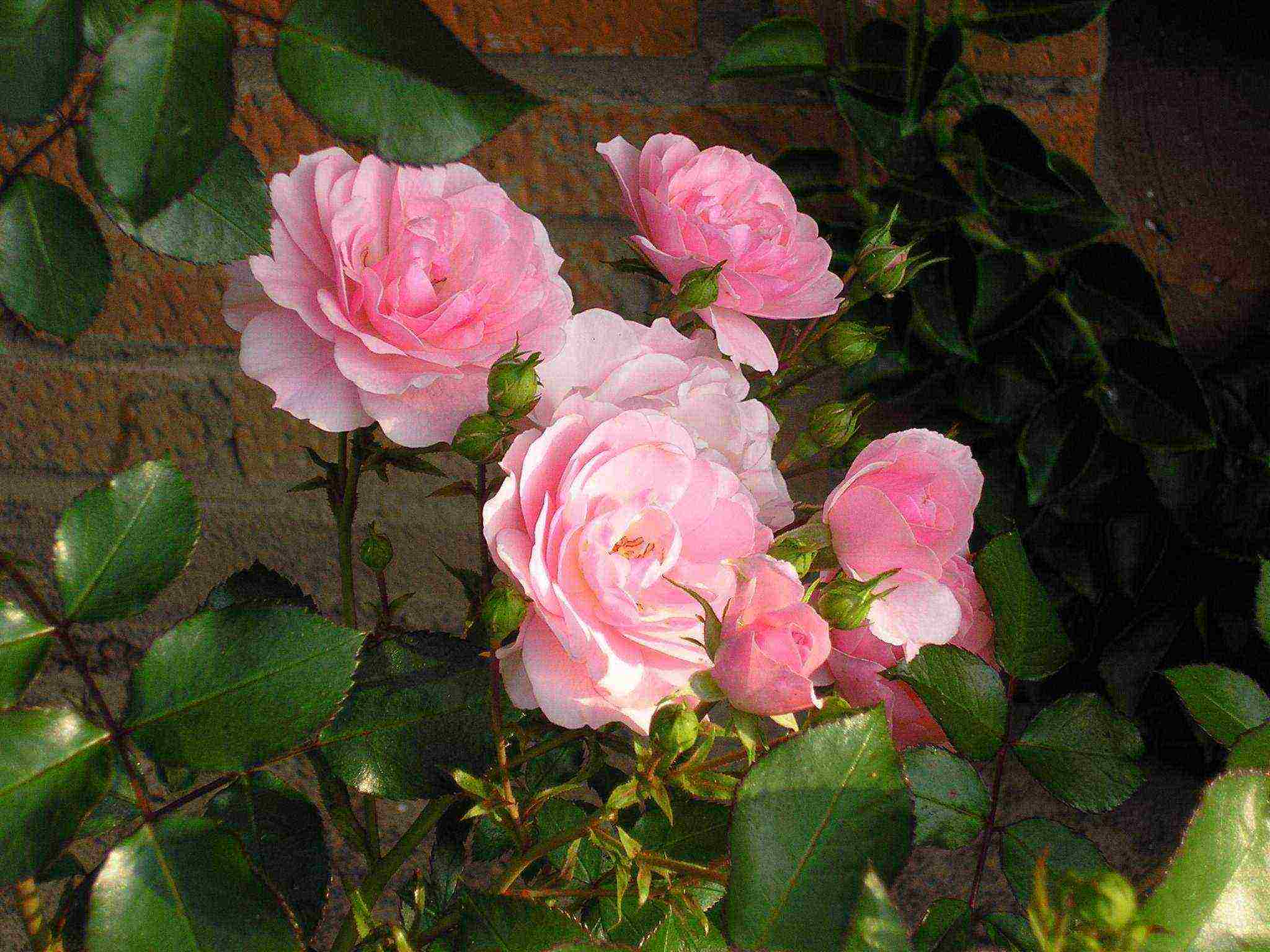
Origin, history of the appearance of the royal flower
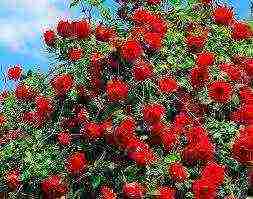 There are many disagreements as to which country belongs to the right to be called the discoverer of this noble beauty. For example, the Persians regarded the rose as a gift from Allah, by the way, it is the ancient inhabitants of the southern part of Iran who are considered the first "breeders" who created a rose by grafting it onto a wild rose hip. Although the Chinese also claim the title of "rightholder country."
There are many disagreements as to which country belongs to the right to be called the discoverer of this noble beauty. For example, the Persians regarded the rose as a gift from Allah, by the way, it is the ancient inhabitants of the southern part of Iran who are considered the first "breeders" who created a rose by grafting it onto a wild rose hip. Although the Chinese also claim the title of "rightholder country."
In official sources, ancient Rome is called the birthplace of roses. Practical Romans paid a lot of attention to good health and good physical shape, so mainly vegetables, fruit trees, spicy and medicinal herbs grew in their gardens. But, nevertheless, even such rational Romans found a place for a beautiful, fragrant flower with thorns. This is confirmed by the work of Herodotus, dated to the 5th century. BC. In his History, he mentions the beautiful gardens of Midos, who reigned at that time. It was there, among many other garden and horticultural crops, that magnificent double roses grew.
After the fall of the Roman Empire, rose bushes migrated to the monastery gardens. At the end of the 19th century, practically in all countries of the world, the widespread breeding of new varieties of the "queen of flowers" began. Today there are a myriad of varieties and varieties of roses. Read an article about the most popular varieties of peonies.
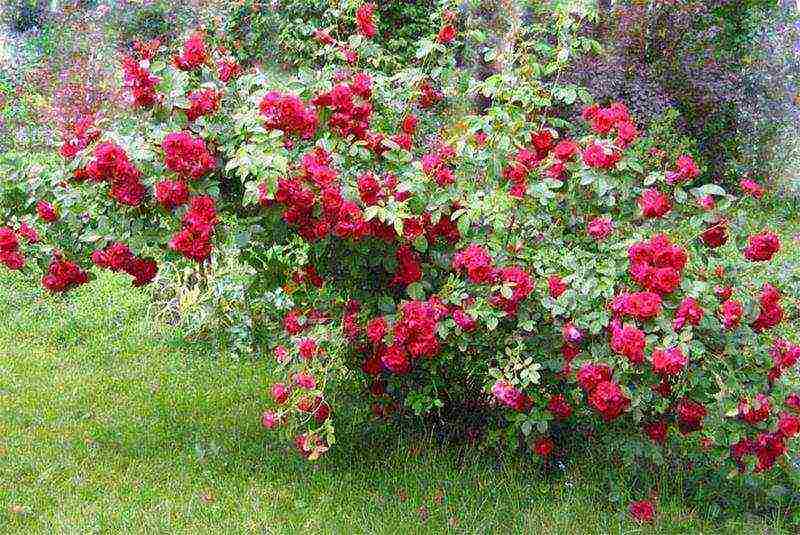 Varieties and varieties of roses
Varieties and varieties of roses
All varieties of roses belong to one or another group, depending on the height of the bush, its shape, the arrangement of flowers on it and many other features. It will be more expedient to start a description of the varieties of roses with a small excursion into the classification of this flower, belonging to the Rosehip genus, which became the original "parent" of all species, shapes, types and varieties. It is now common practice to group all varieties into the following categories.
Hybrid tea rose
 In the sixties of the nineteenth century, a new hybrid rose appeared, obtained from two types - tea and remontant. The creator of a wonderful variety, unusually popular to this day, is the French breeder Guillot. He took as a basis for his "masterpiece" a rose called "LaFrance" and brought out the basis - a hybrid rose, which later served as the progenitor of a great variety of varieties.
In the sixties of the nineteenth century, a new hybrid rose appeared, obtained from two types - tea and remontant. The creator of a wonderful variety, unusually popular to this day, is the French breeder Guillot. He took as a basis for his "masterpiece" a rose called "LaFrance" and brought out the basis - a hybrid rose, which later served as the progenitor of a great variety of varieties.
All hybrid varieties of roses have one feature - they either bloom continuously throughout the season, or take a short "time-out", but then they also continue to delight the soul until the very end of summer - early autumn. Various varieties of hybrid tea roses will allow you to choose the right bush to decorate any garden area. Many people may like hybrid tea roses: varieties of some of these beautiful flowers will be discussed below.
It is difficult to say which hybrid rose varieties are the best or the most beautiful.But you can make a rating from those that not only look great, but also meet many other requirements: frost resistance, easy maintenance, good resistance to diseases and pests.
Variety Parole
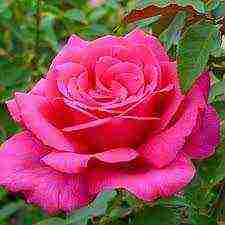 The combination of beauty and durability is distinguished by the Parole hybrid tea rose. It appeared relatively recently, in 2001, but has already won the hearts of many gardeners. Everything is fine in it: both appearance, and unpretentiousness, and good frost tolerance. Despite the fact that it is still very young, compared to many other varieties, the Parole hybrid rose has already won many awards at various competitions. She won one of the awards for its great scent.
The combination of beauty and durability is distinguished by the Parole hybrid tea rose. It appeared relatively recently, in 2001, but has already won the hearts of many gardeners. Everything is fine in it: both appearance, and unpretentiousness, and good frost tolerance. Despite the fact that it is still very young, compared to many other varieties, the Parole hybrid rose has already won many awards at various competitions. She won one of the awards for its great scent.
Its distinctive feature is the large size of the flower, because its diameter can reach up to 20 cm. According to the internal composition of the petals, it is terry, the shape is goblet.
Her color is no less impressive. Monochromatic - pink, with hints of purple hues, in color it vaguely resembles classic fuchsia.
The bushes are quite compact: width - 0.5 m, height - 0.8 m. Leaves are glossy, large, dark green. Stems are strong, erect, on each of them 1-3 flowers are tied. This flower best represents winter-hardy varieties of roses, tolerates frosts with dignity, but, like any other varieties, needs to cover the roots for the winter. Its disadvantage can be considered the fact that, dissolving, it retains its shape for a short time, and the edges of the petals become tied with prolonged exposure to hot sunlight. Heavy rain can also damage flowers.
Grade Grand Amore
All the disadvantages of the Parole variety are more than covered by the Grand Amore rose.
She is not afraid of the effects of severe cold in winter, searing heat in summer. It will withstand the "shelling" of large drops of a summer shower.
 Moreover, the flower has a catchy appearance. Red, double roses with a subtle, barely perceptible aroma will become a real accent of color in any flower bed. In addition, the buds are formed one by one on the stem, so they are perfect for cutting into bouquets. Having fully opened, the flower reaches a size of 9-10 cm in diameter.
Moreover, the flower has a catchy appearance. Red, double roses with a subtle, barely perceptible aroma will become a real accent of color in any flower bed. In addition, the buds are formed one by one on the stem, so they are perfect for cutting into bouquets. Having fully opened, the flower reaches a size of 9-10 cm in diameter.
Bushes, 70-80 cm high, about 40 cm wide, neat, compact. The foliage is initially dark green with a brownish-red tint, then takes on a classic shade.
The variety was bred in Germany in 2004, and is characterized by simply incredible resistance to external factors: rain, heat, frost, pests, diseases. It is very unpretentious, therefore it is suitable for those who have never been involved in rose growing and want to try themselves in this area for the first time.
Gloria Day variety
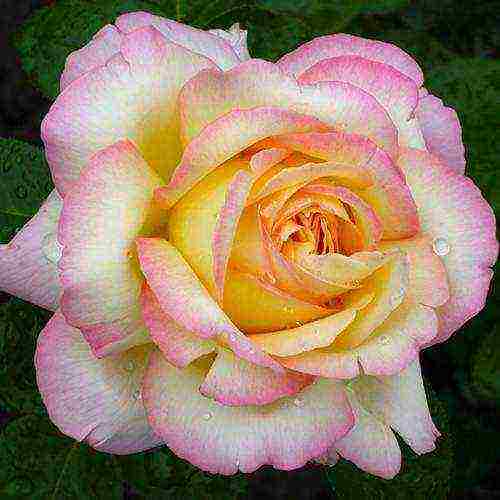 Frenchman Francis Meilland created this beautiful rose and named it after his mother. In the late forties of the last century, the Gloria Day rose was released and immediately became one of the most beloved and widespread varieties of flowers around the world. And it's not just about its extraordinary coloring and wonderful smell. She is just a real "tin soldier" among roses: she feels great in regions with the most difficult climates, withstands severe winters (provided the roots are protected). She endures other "whims of nature" with the same noble dignity. A suitable variety for growing in the Moscow region, Siberian, Ural regions.
Frenchman Francis Meilland created this beautiful rose and named it after his mother. In the late forties of the last century, the Gloria Day rose was released and immediately became one of the most beloved and widespread varieties of flowers around the world. And it's not just about its extraordinary coloring and wonderful smell. She is just a real "tin soldier" among roses: she feels great in regions with the most difficult climates, withstands severe winters (provided the roots are protected). She endures other "whims of nature" with the same noble dignity. A suitable variety for growing in the Moscow region, Siberian, Ural regions.
Roses of the Gloria Day variety are quite large (15-19 cm), double, goblet-shaped during the unfolding of the bud, cup-shaped - after the flower has fully opened. The color also changes as it blooms: petals of various yellow shades. In the description of the variety, you will not find an interesting feature that is inherent in this flower. The fact is that it changes the ratio of colors and shades depending on the temperature regime. When the air is warmed up to t + 15- + 25 ° С, it retains varietal characteristics in color. But if the temperature exceeds + 25 ° C, then the basic color range begins to tend to creamy white, and the edge becomes brighter.
The size of the bush is rather big: height - 1.0-1.2 m, and diameter - 80-90 cm. Leaves are dark green, branchy shoots.
Polyanthus group of roses
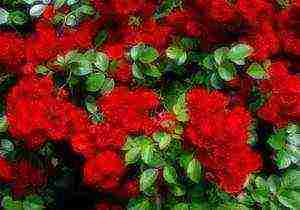 The polyanthus group includes varieties with a large number of roses on one branch. Their bushes are a gorgeous riot of flowers and buds that literally "dot" the plant. Most often, the polyanthus rose is used as a park culture for the design of all kinds of landscape compositions. Flowers are not large in size (their diameter is ≈4 cm), but they are collected in lush inflorescences, 30-40 pieces or more. It is this feature that gives them splendor, it is difficult to take your eyes off them, they are so beautiful.
The polyanthus group includes varieties with a large number of roses on one branch. Their bushes are a gorgeous riot of flowers and buds that literally "dot" the plant. Most often, the polyanthus rose is used as a park culture for the design of all kinds of landscape compositions. Flowers are not large in size (their diameter is ≈4 cm), but they are collected in lush inflorescences, 30-40 pieces or more. It is this feature that gives them splendor, it is difficult to take your eyes off them, they are so beautiful.
Floribunda rose group
 There are many disagreements around this group of varieties, or rather, in connection with who belongs to the primacy in its breeding. Some believe that Peter Lambert should have this right, others refer to Poulsen. But most opinions boil down to the fact that the floribunda in the form in which modern growers are used to seeing it was created by Eugene Berner, a breeder from the United States. Therefore, it is his name that most often sounds when it comes to the creator of this type of flower. No wonder he was nicknamed "the father of Floribunda."
There are many disagreements around this group of varieties, or rather, in connection with who belongs to the primacy in its breeding. Some believe that Peter Lambert should have this right, others refer to Poulsen. But most opinions boil down to the fact that the floribunda in the form in which modern growers are used to seeing it was created by Eugene Berner, a breeder from the United States. Therefore, it is his name that most often sounds when it comes to the creator of this type of flower. No wonder he was nicknamed "the father of Floribunda."
A distinctive feature of this class of roses is a combination of the graceful forms of a hybrid tea rose and pomp, borrowed from the polyanthus varieties of the plant. It was these two species that were crossed to create the classic Floribunda.
The category of floribunda roses is very diverse: the varieties included in it can belong to border roses, the height of which does not exceed 40 cm. There are also medium-sized roses (70-80 cm), and tall specimens - 1 m and above. According to the density of the petals in the bud, they are simple, semi-double and double, densely double. And there is nothing to say about the color scheme - the buds are painted in almost all colors of the rainbow, there are even striped representatives.
Rumba rose variety
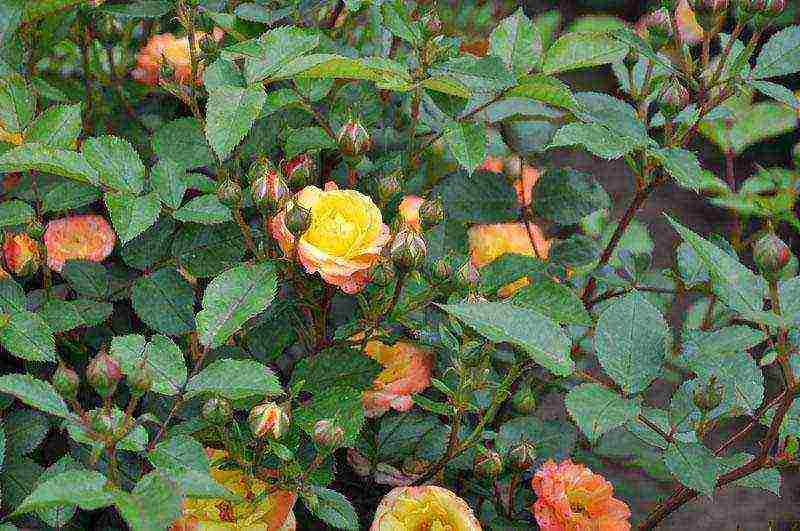 The floribunda Rumba rose can boast of the most beautiful outfit, because it looks so much like the layered skirts of Latin American girls dancing to the rhythms of national music. For more than half a century, she continues to give her beauty and aroma to people. Her colorful "outfit" is difficult to confuse with any other. After all, the central part of the "skirt" is bright yellow, and the "flounces" along the edges of red or deep orange are not the most common color combination among roses.
The floribunda Rumba rose can boast of the most beautiful outfit, because it looks so much like the layered skirts of Latin American girls dancing to the rhythms of national music. For more than half a century, she continues to give her beauty and aroma to people. Her colorful "outfit" is difficult to confuse with any other. After all, the central part of the "skirt" is bright yellow, and the "flounces" along the edges of red or deep orange are not the most common color combination among roses.
Bushes are undersized, symmetrical (70x70 cm), with dark green foliage, without thorns. From 4 to 20 roses can be located on one stem. Blooms all summer with a short break. The disadvantage of the variety is that the petals do not fly around after flowering, but remain on the shoots, so they must be cut off. This deficiency is covered by the good tolerance of wet weather and infertile soils.
Grandiflora is the youngest type of roses
Not so long ago, this type of roses appeared, and they got it using two floribundas and a hybrid tea variety.
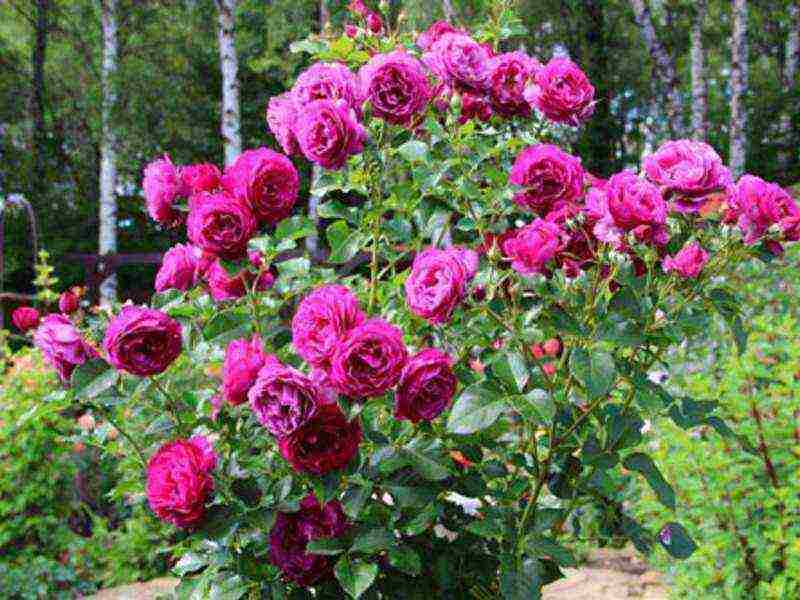 It combines some of the features of both forms. The unsurpassed decorative qualities are inherited from the hybrid tea type, and the huge number of buds and their long flowering were borrowed from the floribunda.
It combines some of the features of both forms. The unsurpassed decorative qualities are inherited from the hybrid tea type, and the huge number of buds and their long flowering were borrowed from the floribunda.
The bushes of grandiflora are tall, reaching two meters in height. Flowers are collected in clusters of 4-5 pieces, they are rather large in size. The most famous representative of this group is the Queen Elizabeth rose, which will be discussed further.
Queen Elizabeth variety
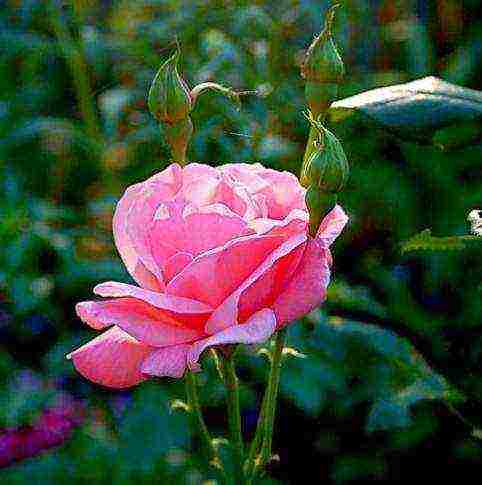 The Queen Elizabeth variety got its name in honor of the current Queen of Great Britain. The rose is considered one of the most beautiful in the world. Its delicate, pink color and exquisite shape, sophisticated aroma to match the name. The blossoming flower reaches 10 cm in diameter, and is accompanied by a “retinue” of several buds on the sides. Despite the monarch's name, the bush is very simple in everyday life. It does not require special approaches, it blooms almost all summer, starting in July.Flowering ends in late autumn, closer to October, when the first frosts fall on the ground. The bushes are densely decorated with many fragrant, delicate shades of roses, they grow up to 1.8 m high, so small flower beds are not suitable for them.
The Queen Elizabeth variety got its name in honor of the current Queen of Great Britain. The rose is considered one of the most beautiful in the world. Its delicate, pink color and exquisite shape, sophisticated aroma to match the name. The blossoming flower reaches 10 cm in diameter, and is accompanied by a “retinue” of several buds on the sides. Despite the monarch's name, the bush is very simple in everyday life. It does not require special approaches, it blooms almost all summer, starting in July.Flowering ends in late autumn, closer to October, when the first frosts fall on the ground. The bushes are densely decorated with many fragrant, delicate shades of roses, they grow up to 1.8 m high, so small flower beds are not suitable for them.
Wrinkled rose and its characteristics
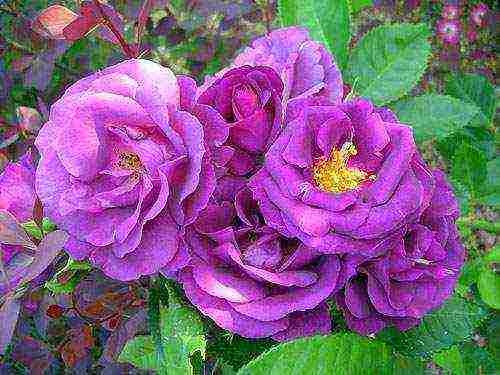 Often in parks you can see a rose, very similar to a rose hip. An unusually fragrant shrub generously strewn with multi-colored double or simple roses. Park roses are often called, but they have their official name - wrinkled rose. The historical homeland of this species is the Far Eastern hills and Chinese latitudes. Therefore, all varieties of Rosa Rugosa (scientific name) are hardy, unpretentious and easy to care for. The most famous representative of the group is the wrinkled rose Alba, a flowering shrub that produces orange fruits. Flowers are double, snow-white, in the form of a flat bowl. The height of the bush is 1.5 m, the same size and width. The shrub has a lifespan of about 30 years. Flowering begins in June and lasts until autumn.
Often in parks you can see a rose, very similar to a rose hip. An unusually fragrant shrub generously strewn with multi-colored double or simple roses. Park roses are often called, but they have their official name - wrinkled rose. The historical homeland of this species is the Far Eastern hills and Chinese latitudes. Therefore, all varieties of Rosa Rugosa (scientific name) are hardy, unpretentious and easy to care for. The most famous representative of the group is the wrinkled rose Alba, a flowering shrub that produces orange fruits. Flowers are double, snow-white, in the form of a flat bowl. The height of the bush is 1.5 m, the same size and width. The shrub has a lifespan of about 30 years. Flowering begins in June and lasts until autumn.
Stamp or stamp rose
A stamp or stamp rose differs from all the others in that it grows not as a bush, but as a tree. They are undersized (45 cm), half-stem (70-80 cm) and ordinary standard (up to 1m). These roses are obtained using a rosehip rootstock and a scion of different varieties of roses. Roses-trees look very decorative. Many varieties of climbing roses lose against the background of such a miracle, especially if it is created in the form of a cascade.
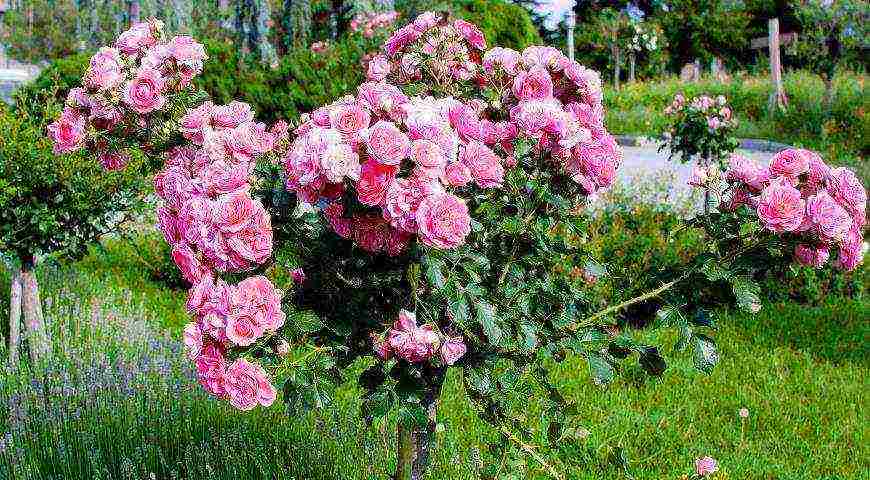
Stamp rose
Mini roses in gardens and flower beds
A special place in gardens and flower beds is occupied by miniature roses, which are small bushes with tiny roses of different shades. Starting in the distant 1810, they settled in European houses, after they were brought to the Old World from the Middle Kingdom. The main advantage that mini roses have is the ability to grow a wonderful, compact plant at home: on a windowsill or loggia. Although mini-roses in the garden are in no way inferior to their tall relatives.


